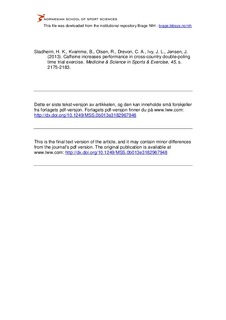| dc.contributor.author | Stadheim, Hans Kristian | |
| dc.contributor.author | Kvamme, Bent | |
| dc.contributor.author | Olsen, Raymond | |
| dc.contributor.author | Ivy, John L. | |
| dc.contributor.author | Drevon, Christian A. | |
| dc.contributor.author | Ivy, John L. | |
| dc.contributor.author | Jensen, Jørgen | |
| dc.date.accessioned | 2014-11-24T10:00:49Z | |
| dc.date.available | 2014-11-24T10:00:49Z | |
| dc.date.issued | 2013-11 | |
| dc.identifier.citation | Medicine & Science in Sports & Exercise. 2013, 45, 2175-2183 | nb_NO |
| dc.identifier.uri | http://hdl.handle.net/11250/226343 | |
| dc.description | I Brage finner du siste tekst-versjon av artikkelen, og den kan inneholde ubetydelige forskjeller fra forlagets pdf-versjon. Forlagets pdf-versjon finner du på www.lww.com: http://dx.doi.org/10.1249/MSS.0b013e3182967948 / In Brage you'll find the final text version of the article, and it may contain insignificant differences from the journal's pdf version. The original publication is available at www.lww.com: http://dx.doi.org/10.1249/MSS.0b013e3182967948 | nb_NO |
| dc.description.abstract | PURPOSE: Caffeine (CAF) improves performance in both short- and long-duration
running and cycling where performance relies on power output and endurance
capacity of leg muscles. No studies have so far tested the effects of CAF while
using the double-poling (DP) technique in cross-country skiing. When using the DP
technique, arm muscles provide the speed-generating force and therefore play an
important role in performance outcome. The metabolism of arm muscles differs from
that of leg muscles. Thus, results from studies on leg muscles and CAF may not be
directly applicable to exercises while using the DP technique in cross-country
skiing. The purpose of our study was therefore to investigate the effects of CAF
on exercise performance in DP. METHOD: Ten highly trained male cross-country
skiers (V.O 2max running, 69.3 +/- 1.0 mL . kg . min(-1)) performed a placebo
(PLA) and CAF trial using a randomized, double-blind, crossover design.
Performance was assessed by measuring the time to complete an 8-km cross-country
DP performance test (C-PT). CAF (6 mg . kg(-1)) or PLA was ingested 75 min before
the C-PT. RESULTS: CAF ingestion reduced the time to complete the 8-km C-PT from
34:26 +/- 1:25 to 33:01 +/- 1:24 min (P < 0.05). The subjects maintained higher
speed and HR throughout the C-PT, and lactate was higher immediately after the
C-PT with CAF exposure compared with PLA. Subjects reported lower RPE at
submaximal intensities during CAF compared with PLA, although HR was similar.
CONCLUSION: CAF intake enhances endurance performance in an 8-km C-PT, where arm
muscles limit performance. CAF ingestion allowed the participants to exercise
with a higher HR and work intensity possibly by reducing perception of effort or
facilitating motor unit recruitment. | nb_NO |
| dc.language.iso | eng | nb_NO |
| dc.publisher | LWW | nb_NO |
| dc.subject | adult | nb_NO |
| dc.subject | arm | nb_NO |
| dc.subject | athletic performance / physiology | nb_NO |
| dc.subject | blood glucose / metabolism | nb_NO |
| dc.subject | caffeine / blood | nb_NO |
| dc.subject | caffeine / pharmacology | nb_NO |
| dc.subject | central nervous system stimulants / blood | nb_NO |
| dc.subject | central nervous system stimulants / pharmacology | nb_NO |
| dc.subject | cross-over studies | nb_NO |
| dc.subject | double-blind method | nb_NO |
| dc.subject | epinephrine / blood | nb_NO |
| dc.subject | heart rate / drug effects | nb_NO |
| dc.subject | lactic acid / blood | nb_NO |
| dc.subject | male | nb_NO |
| dc.subject | muscle, skeletal | nb_NO |
| dc.subject | norepinephrine / blood | nb_NO |
| dc.subject | oxygen consumption / drug effects | nb_NO |
| dc.subject | physical exertion / drug effects | nb_NO |
| dc.subject | skiing / physiology | nb_NO |
| dc.subject | time factors | nb_NO |
| dc.subject | young adults | nb_NO |
| dc.title | Caffeine increases performance in cross-country double-poling time trial exercise | nb_NO |
| dc.type | Journal article | nb_NO |
| dc.type | Peer reviewed | nb_NO |
| dc.subject.nsi | VDP::Social science: 200::Social science in sports: 330::Other subjects within physical education: 339 | nb_NO |
| dc.source.journal | Medicine & Science in Sports & Exercise | nb_NO |
| dc.description.localcode | Seksjon for fysisk prestasjonsevne / Department of Physical Performance | nb_NO |
